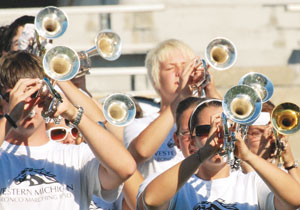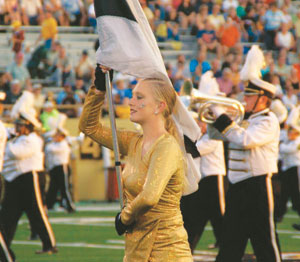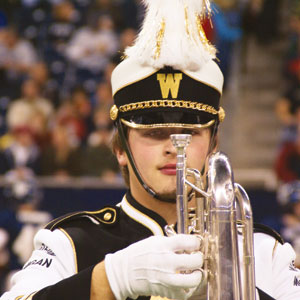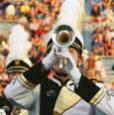 The secret to a productive rehearsal is having a specific plan. This includes knowing exactly how much time to spend on basics, music, and drill as well as specific objectives. I plan for each two-hour marching rehearsal in 10-minute blocks of time. Some tasks may require only five minutes while others may take 15-20 minutes, but in my experience, having a goal roughly every ten minutes will keep rehearsals moving and students focused. Even if I schedule a 50-minute sectional in the beginning of the season, I still look to break that up into five 10-minute segments with specific goals for each segment.
The secret to a productive rehearsal is having a specific plan. This includes knowing exactly how much time to spend on basics, music, and drill as well as specific objectives. I plan for each two-hour marching rehearsal in 10-minute blocks of time. Some tasks may require only five minutes while others may take 15-20 minutes, but in my experience, having a goal roughly every ten minutes will keep rehearsals moving and students focused. Even if I schedule a 50-minute sectional in the beginning of the season, I still look to break that up into five 10-minute segments with specific goals for each segment.
Each rehearsal begins with the band in a marching fundamentals block. I will often take the first ten minutes of rehearsal to review basics or have students practice special maneuvers used in the show. Because some visually interesting maneuvers, such as the Texas two-step, are complicated to explain, I usually teach these in basics block to save time and reduce confusion when learning drill.
Starting with marching fundamentals quickly establishes order and focuses the attention of everyone on the work at hand. After completing work on marching fundamentals I announce the goals for the rehearsal, and then the band moves to a musical warmup. If space permits, it is best to have the drumline and colorguard go to separate locations to warm up.
Music
I believe the music must come before the drill, otherwise the drill is just a confusing exercise in memorizing counts. If students learn the music first they can connect the motion on the field to a broader concept.
At the start of the season, a music segment will consist of reading through each piece while I notate any awkward spots and work through them slowly. Problems may also become a scheduled segment at the next rehearsal. I might also schedule 20 minutes to practice a list of things in the first half of a tune. A typical entry in my rehearsal plan might look like this:
City of Angels: Big breath right before measure 9. Mellos and altos to play out on the decending accents in 13-14. Band should feel the transition to allegro with mark time while listening for eighth notes in preceding measure. Trombones get off ties. All eighth-note pickups should be short in allegro section. Memorize 1-36.
The next two segments of rehearsal would build on this.
(20 minutes) Guard/Percussion return from sectionals; City of Angels: Percussion eyes on drum major for transition to allegro. Bass drum eighth-note pulse becomes quarters in the allegro. Drums play out through horn line fp. Horn line listen back to percussion for tempo – no rushing. Eighth-note pickups in horn line must match with snares each time. Memorize 1-36.
As the season progresses I might devote 10 minutes to just a few measures of music. A difficult, two-measure woodwind lick may fill a 10-minute slot, which can be broken down even further. I might hear alto saxes for a minute, then clarinets, then flutes, then all three sections together for two minutes, then the full band for the last five. The goal is to keep the rehearsal moving while being diligent about the problems to be fixed. Too many times directors take a stop-and-fix-it approach, which drives players crazy and is an entirely reactive strategy.
Marching
I have learned a couple tricks to make teaching and cleaning drill go more smoothly. One is to have students end every move in rehearsal by coming to attention and remaining quiet. With everyone silent and.jpg) still I can make comments and give feedback without having to compete for the band’s attention. After I make my comments, there is time for the other instructors to make corrections while everyone remains in the freeze position.
still I can make comments and give feedback without having to compete for the band’s attention. After I make my comments, there is time for the other instructors to make corrections while everyone remains in the freeze position.
Another is after a command to reset, I give students 10 seconds to hurry back to their starting location. Without a time limit, students usually meander back to the starting location. In the time saved with a countdown, I can often get in one more runthrough at the end of each rehearsal. Some directors prefer to reset by marching the band back to its starting location with a cadence or drum taps, but I find resetting to be quicker and less confusing. Plus, it gives students a few seconds to decompress, which improves their focus during a long rehearsal. This is especially helpful when marching practice is held after a full day of school.
It generally takes about 10 minutes to learn a page of drill. I give students one or two minutes, depending on the difficulty of the maneuver, to find where they have to go, and then we spend the next eight to nine minutes going back and forth to learn and memorize the move. We do the same for each page of drill on the schedule that day. Depending on the complexity of each move, we will learn two to four pages and then spend 10 minutes running those sets back to back.
Here is an example of how the schedule for a new drill move might look:
Learn the move from set 4 to set 5. Woodwinds follow the leader, everyone else reshapes.
 I try to anticipate problems that may arise and may schedule two 10-minute segments to learn complex drill moves, such as a pass-through. I begin these by placing students at the count where the pass-through happens, which may be count eight of a 16-count move. With students at the pass-through point, they can see the spacing and who is adjacent. Next we run through the pass-through slowly several times before increasing the tempo.
I try to anticipate problems that may arise and may schedule two 10-minute segments to learn complex drill moves, such as a pass-through. I begin these by placing students at the count where the pass-through happens, which may be count eight of a 16-count move. With students at the pass-through point, they can see the spacing and who is adjacent. Next we run through the pass-through slowly several times before increasing the tempo.
For quick reference I will designate particular sets as rehearsal sets by giving them a nickname, such as “star” or “brown.” Typically these are the formations before or after a transition or a particularly complex move. When I call out this name, students know immediately where to go.
I prefer to end each rehearsal with a run-through. If we spent a rehearsal learning sets 4-9, I will schedule the next-to-last 10-minute segment to run through these six sets. The first run-through might have the drums playing while the horns sing; when that is improved, the full band will march and play several times. In the final 10 minutes of rehearsal we might review the first nine drill sets.
Solving Problems
Unanticipated problems arise at every rehearsal. The choice is to either grind rehearsal to a halt and waste time experimenting with a hasty solution or simply make note of what happened, think about it overnight, and come up with the best approach for the next rehearsal. It is easy to become sidetracked by the unexpected, and I find it is better to remain focused on the scheduled goals for that day.
 I urge young directors to give specific instructions, not general observations. Instead of a long-winded explanation, boil it down to what students should do. Rather than explain the acoustic properties of low brass instruments, simply say, “Play shorter and it won’t drag.”
I urge young directors to give specific instructions, not general observations. Instead of a long-winded explanation, boil it down to what students should do. Rather than explain the acoustic properties of low brass instruments, simply say, “Play shorter and it won’t drag.”
There is no magic to a rehearsal comprised of 10-minute segments, but this kind of planning focuses my teaching. Although I pay attention to the pacing and timing of each rehearsal, I keep things flexible enough to spend more or less time on a given segment as long as the band is making progress. What is important is for the director to have a specific plan and goals for each rehearsal and a clear idea of how best to reach them.
Sidebar: Getting off to a Good Start
In addition to planning the actual rehearsal, it is important to have everything ready to go at least 10 minutes before the rehearsal starts. Student loading crews can take responsibility for front ensemble and color guard equipment, field markers, podiums, public address systems, and water for breaks. Having everything in place at least 10 minutes before rehearsal gives the student crew enough time to handle unexpected equipment problems as well as enough time to warm up. Without this cushion of time, students and directors are rarely mentally and physically ready to begin a productive rehearsal.
Rehearsals should start on time. When they consistently start five minutes late and end 10 minutes late, students do not show up on time and do not focus when they are there. Starting and ending on time shows students that you mean what you say and you believe time is valuable.
It is also beneficial to define procedures and specify when things are permitted. As I instruct students to freeze at the end of each drill run-through, I also have procedures in place for such non musical activities as taking attendance and turning in money. The ways in which a rehearsal can be derailed are many; careful planning and preemptive instruction can save the director and students from unnecessary headaches and will lead to more effective rehearsals and better performances.
.jpg)






